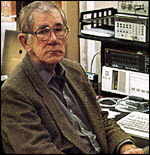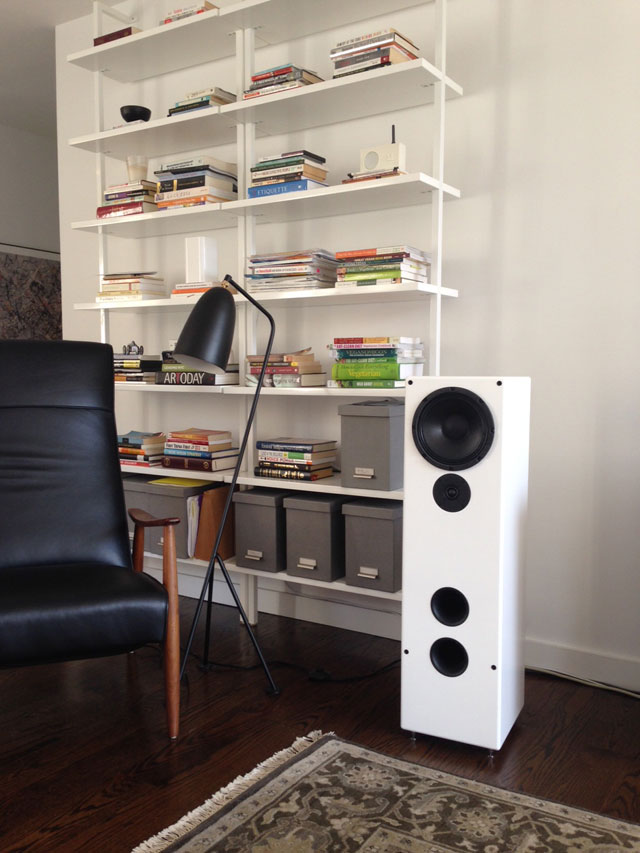Tekton Design Lore Reference Loudspeakers

 Disclosures and regulatory interventions: Speaker designer Eric Alexander is a big part of my life (Not in that way… Not that there’s anything wrong with that). He is also, since a young age, a self-defined “audiophile” who hung out with other self-defined audiophiles. His definition of the term? During a recent phone call/pseudo-interview with me, he defined audiophiles as “People who sit down in an equilateral triangle [play music] and pretend they’re having a religious experience.”
Disclosures and regulatory interventions: Speaker designer Eric Alexander is a big part of my life (Not in that way… Not that there’s anything wrong with that). He is also, since a young age, a self-defined “audiophile” who hung out with other self-defined audiophiles. His definition of the term? During a recent phone call/pseudo-interview with me, he defined audiophiles as “People who sit down in an equilateral triangle [play music] and pretend they’re having a religious experience.”
Spot on sir!! Spot on. All through college that was me — the guy with the seven-foot tall electrostats (Sound Labs) in a six foot tall (dorm) room, hooked up to a Counterpoint amplifier (Oh how we miss ye), swapping preamps and CD players every two weeks and trying to get the third violin from the left on Reference Recordings’ Symphonie Fantastique to sound just like Harry Pearson said it should—IN my friggin’ (dorm) room!! Religious to the core.
Actually, Eric may not have had a similarly religious collegiate experience; or at least, he may have practiced in an altogether different parish. He explained to me during the self-same phone call/pseudo-interview that, “When I shoulda been in college, I literally lived in my cabinet shop – had all the formulas memorized. I’d make box after box after box, crossovers and cabinets, for years and years. I’ve put in my 10,000 hours and then some.” Malcolm Gladwell would be…glad.
Well, I know for a fact that I’m glad to be the beneficiary of Eric’s shirking of his civic responsibilities as a collegiate audiophile, which include chiefly getting drunk, refraining from going to class at all costs and explaining ad nauseum to women visiting your six foot tall dorm room that yes – those are speakers that plug into a wall and no!!! You cannot—MUST NOT— touch them!! (Or ever bring your cat over again. Ever!)
Okay so I am not the sole beneficiary of Eric’s monastic early years; there are others. And if the Lore Reference is any gauge, there will soon be multitudes. This will not bode well for Tekton Designs, Eric’s ship-of-state, which is still recovering from a massive overload of demand/production slow-down when the good news about Tekton’s extraordinary sound-per-pound first got out in force on The Google a couple years back.
At the time, Eric was like the only guy working at his company so he couldn’t very well fire himself over the issue. Moreover, he was mired in a Seattle Slew of personal problems from which he has since (audiophile deities be praised) largely extricated himself. He is now free(er) to think, to sip lattes and to dream. Plus, there are now at least like three people (okay more like 10 or 20 people) working for him. I can only hope they are strong of back and quiet of mind, and drink Red Bull out the yin yang. They will need to focus.
Seriously, who are you working for?! What is this secret?! Tell us! Tell us!!
 The Tekton Lore Reference is (get ready for shocking-ness) an update of the original Tekton Lore and represents some ‘newer’ thinking on the part of Mr. Alexander regarding certain aspects of loudspeaker design. Whereas the original Lore utilized an off-the-shelf driver, Eric tells me the driver in the Lore Ref is an 8 incher he had “built to my specifications by Eminence.” It’s lighter overall in construction, and that’s about all he’d say about it. He also told me the tweeter in the Ref is SEAS tweeter, whereas the tweeter in the original Lore is an Audax. If you don’t hear anything ‘groundbreaking’ in the above speaker comparison – good. You’re playing right into Eric’s grizzled cabinet-makers’ hands. Indeed, Eric actually wanted me to stress in any review that there is “nothing in the Lore Reference that is groundbreaking—in fact, quite the contrary.” Say what?!
The Tekton Lore Reference is (get ready for shocking-ness) an update of the original Tekton Lore and represents some ‘newer’ thinking on the part of Mr. Alexander regarding certain aspects of loudspeaker design. Whereas the original Lore utilized an off-the-shelf driver, Eric tells me the driver in the Lore Ref is an 8 incher he had “built to my specifications by Eminence.” It’s lighter overall in construction, and that’s about all he’d say about it. He also told me the tweeter in the Ref is SEAS tweeter, whereas the tweeter in the original Lore is an Audax. If you don’t hear anything ‘groundbreaking’ in the above speaker comparison – good. You’re playing right into Eric’s grizzled cabinet-makers’ hands. Indeed, Eric actually wanted me to stress in any review that there is “nothing in the Lore Reference that is groundbreaking—in fact, quite the contrary.” Say what?!
He added “I spent years in anechoic chambers paying attention to every detail and the magic of the Lore Reference is in the sum total of its parts.” Aha!! So that’s the secret — balance!
Mr. Miyagi was sooooo wise — sooooo deep — soooo before his time. Fictional character, we hardly knew yeL

The smaller M-Lore,about which I enthused vastly in cyber-ink past, has a single front port, whereas the original Lore (still available) and Lore Reference both have two. Some strange aperiodic quantum gravity loading employed here? Why are they so easy to place in-room, for example? Talk!! Where were you on the night of April 15th??!! Huh! Huh!!!???
“It is classic venting,” sez Eric, obviously bedazzled by my KGB interrogator shtick. “A classic ported design. Butterworth/Bessel, but there are fine tunings and increments which maybe sound a bit better.”

Ha! I knew it!! “Fine tunings and increments” is hippie slang for “floobie dust!” [N.B. John Dunlavy – coiner of the phrase ‘floobie dust’- don’t think we audiophiles have forgotten you or your indelible influence on loudspeaker design and ruler flat frequency response curves. You are just as lamented in our ranks as Mister Miyagi- but one of you was a real person].
Quoth the Raven, never Lore…
I began this Discourse on the Method by sharing with you that Eric Alexander is a big part of my life. And he is — but not actually. His designs, I should say though, very definitely are. And if life and art are one in the same then… then I should shut up and tell you why I love the Lore Reference.
At $699.00 a pair, the smaller M-Lore was a milestone for me. It was not necessarily the very best speaker I’ve heard; that honor goes to speakers like the Devore O/96 with full boat load of Shindo electronics and crazy tricked out (read: $20,000) turntable I heard a year or two ago at In Living Stereo in NYC; or maybe to a reference level Audio Research/Quad electrostat system heard in some long-defunct Long Island stereo retailer’s ‘big room’ years ago; or quite possibly to a Mark Levinson — fronted Sonus Faber Extrema system in a very wealthy man’s living room years ago. The mind boggles and the memory stick blurs…
No, the M-Lore did not quite scale these heights of memory, but that may be down as much to my untreated sparse New York City apartment’s makeshift listening/living room and to the relative dearth of $30,000 of handcrafted Japanese tube amps around my place as well. (Trust me, I’ve looked in the storage unit; nary a Shindo or a Technical Brain to be had, and the guy at Almarro doesn’t even answer my emails. True story.)
So no, the M-lore, with a pair costing what a single unobtainium tube on a high-end Shindo might, doesn’t quite do THOSE things. But to date, in most ways that matter,they are the very best speakers I’ve ever heard in my actual home at any price in 20 years. For speakers costing less than most audiophile speaker wires, that’s saying something. That I had zero desire to upgrade after getting them says something else.
Like all advancements over the already very very good, the Lore Reference improves upon the original M-Lore in some ways that will be meaningful to some people.

Firstly, and most obviously, it is bigger; two inches taller, an inch wider and two inches deeper.
Classical physics being err… classical, the Lore Ref packs perhaps a bit more punch than the M-Lore in the nether-regions, though I found that due to the wonderful voicing of both speakers, at the volumes at which I typically listen and with the music I typically listen to, I did not notice huge differences in the weightiness of the sound. ‘Tis true though that with the Lore Ref, I sometimes thought I was hearing my neighbor’s bass from an adjoining apartment but in fact it was some “under the mix” bassline from a Fred Hersch jazz abum I was listening to (Alive at The Vanguard in that case) or what have you. A neat trick!
Once you turn up the wick somewhat or put on more bass heavy material (or both) you can notice the bit bigger, though equally well controlled punch. Hey, the Lore Ref is spec’d down to 37 Hz; one single lonely Hertz lower than the M-Lore. So there ya go.J
Despite this bit more low end punch, the Lore Ref was never boomy in my room and during initial set-up, I found their sonics very easy to tweak simply by moving them closer to or farther out from the front wall and/or closer to or farther from one another. For final positioning, their cabinets ended up roughly 15 or 16 inches from said front wall, and they seemed happiest roughly 7 to 7.5 feet apart measured tweeter to tweeter and 9’ 5 and 15/16th inches (laser measurerJ) from ear to tweeter. Incidentally, never use a tape measure again when setting up your speakers. I find it so easy to equalize distance with an inexpensive laser measuring device (I use a Bosch) and they are so accurate. Assuming your front wall is roughly square to the one behind you, get the speakers about equidistant from the front wall with the laser measurer, then just sit on your couch approximately in an equilateral triangle with them, put the back of the laser measurer up to your right ear and aim the beam at the right speaker, then do the same for the left ear distance to the same point on the left speaker and repeat like 4 or 5 times because you’re an audiophile and to be sure you weren’t moving your head too much. You’re welcome.
Now returning to the speaker itself, secondarily, likely due to the up-rated/somewhat bespoke driver compliment, the Lore Ref seems to me a bit more refined than the M-Lore (with original driver complement). The M-Lore really nails transients and hammer strikes on strings and pizzicato, etc., but with a great recording of piano and great piano playing, exemplified by David Fray’s new Schubert album [Erato album as streamed via Tidal], it seems the newer Lore Reference has a bit of an edge on tonal color and sonority. At the right volume level for your venue, David Fray could certainly be playing right there in your room, in that both the scale and tonal qualities of the piano are exemplary and suggestive of a “real” piano in a “real” hall. Similarly, a newer recording of Mozart: Violin Concertos with Vilde Frang as soloist on Warner Classics (thanks again Tidal!), comes spilling easily into the listening room in a wide arc, extending just outside the speakers outer edges with a pure and natural tonality and no artificial “pinpointing” of the soloist.
While the Lore Reference is in large measure notable for its lack of any particular sonic axe to grind, I will say one especially noteworthy bit of sonic fireworks was the crescendo of a pizzicato violin during the second movement of Tchaikovsky “String Quartet No. 3” on the Vermeer Quartet’s album, Tchaikovsky: String Quartets Nos. 1 and 3 on Cedille Records (streamed via Tidal HiFi). The violin plays a pizzicato line that gradually crescendos and fades back into the blend and via the Lore Ref, so present did this sound- I looked at the left speaker in disbelief. Wow. Don’t need a ticket for the Vermeer Quartet concert, I guess.
All pizzicatos aside, the essence of the thing is that with its ‘up-rated’ driver complement, the Lore Ref seems somewhat more refined tonally than the original M-Lore. Both the M-Lore and the Lore Reference image amazingly well- especially for speakers with broad front baffles which, in that they are straight up un-beveled rectangular boxes, seem to give no quarter to sloping/slanty woodwork designed to minimize diffraction. I mean—the Lore Refs are not say, Totem Model Ones or Audio Physic Step SLE’s, where the violin section may be ten feet to the left of the speaker or something, but the way in which they capture an image strikes me as a beautiful compromise between the hair-raising spatial acrobatics of a small, rock solid mini-monitor and the heavy handedness of (some) very wide baffled speakers.
Another new Tidal streaming selection, the above-named Vilde Frang playing Nielsen’s Violin concerto with the Danish National Symphony [Warner Classics], is an excellent example of what I’m talking about. Here we have a beautiful blend between soloist and orchestra; a ‘big-shouldered’ sound and beautiful string tonality all expertly un-F’d with by the Lore Ref.
In fact, a year or two ago I heard a great demo at New York City’s In living Stereo hi-fi store, in which vinyl was played via Shindo electronics amplifying signal to John Devore’s gorgeous O/96 $12,000 a pair Orangutan speakers. Not only were these speakers stunningly beautiful to look at, but their big (10”) drivers and broad baffles made for a wide and extremely natural vista on the sonic proceedings. No artificial pinpoint placement of singers or violins here – just relative placement of naturally sized and scaled musicians.
Based on my experience with the Lore Reference, I’ll just bet if I subbed them into that rarefied system, there wouldn’t be too much of a sonic shortfall. In point of fact, the Tektons give me a very similar “gestalt”; imaging this particular selection in that same continuous, broad shouldered and ‘meaty’ way without causing the proceedings to sound artificially large or small or putting too fine a point on a single musician or vocalist. At 96 dB, they are even similarly efficient.
In other words – and here’s the bottom line (almost literally): the Tekton Lore Reference sounds to me like the way to go if you can’t afford the Devore O/96 or an $8,000 a pair Audio Note high efficiency speakers, and like what speakers of that ilk do; namely, create broad shouldered, tonally saturated canvases of sound in an effortless and flowing manner with low to medium powered amplifiers of all types. And I do. Like what they do, I mean.
In fact, unless Eric decides to “improve” things even further in the relative short-term, I’ve decided I will likely be buying the review pair. Now what do I do with the spare eleven thousand bucks?! Ah, I know. I’ll pay my rent in Manhattan for like two months and use what’s left over for a few espressos and some artisanal cheese in Brooklyn! Once I get my passport renewed. I mean honestly, who travels to Brooklyn this time of year?!
I bid you peace.


David Abramson
Tekton Lore Reference
Retail Price: $799.00 per pair
Type: Two-way (8” transducer)
Enclosure type: Bass reflex (dual front ports)
Impedance: 8 Ohms
Sensitivity: 96 dB
Frequency range: 37-40000Hz
Recommended amplifier power: 250 Watts power handling
Connection output: Single wire
Dimensions (HxWxD): 36 x 10.25 x 11.75 (inches)
Standard Finishes: black, white, red or gray satin. Inquire about pricing for hardwood veneers or other desired paint finishes
Website: www.tektondesign.com/company.html
Stereo Times Masthead
Publisher/Founder
Clement Perry
Editor
Dave Thomas
Senior Editors
Frank Alles, Mike Girardi, Russell Lichter, Terry London, Moreno Mitchell, Paul Szabady, Bill Wells, Mike Wright, and Stephen Yan,
Current Contributors
David Abramson, Tim Barrall, Dave Allison, Ron Cook, Lewis Dardick, John Hoffman, Dan Secula, Don Shaulis, Greg Simmons, Eric Teh, Greg Voth, Richard Willie, Ed Van Winkle, Rob Dockery, Richard Doran, and Daveed Turek
Site Management Clement Perry
Ad Designer: Martin Perry






Be the first to comment on: Tekton Design Lore Reference Loudspeakers